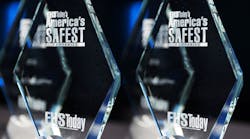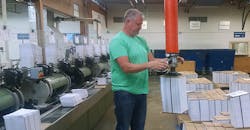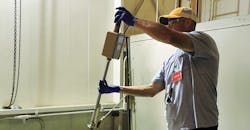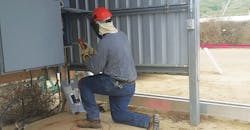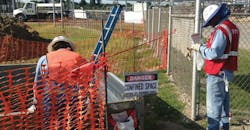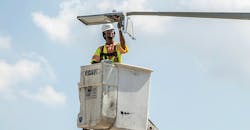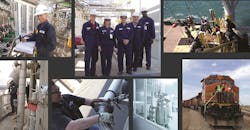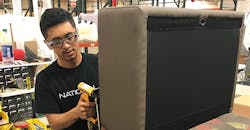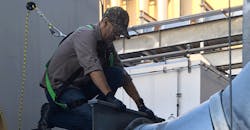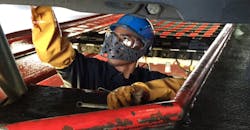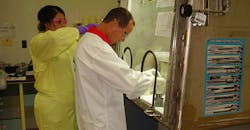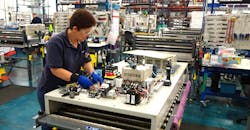Making the phone calls to the companies that have been named to the list of America’s Safest Companies is a highlight of the year for us.
Every company that applies to be one of America’s Safest Companies wants to know two things: First, did they win? Second, how many applications were received?
EHS Today received over 100 applications for 2017, and the winning companies are ACCO Brands Corp., Atkins Energy America, Electrical Systems & Instrumentation, H+M Industrial EPC, Mangan Inc., M.C. Dean Inc., Milliken & Co., National, Nova Group Inc., Texas Instruments Inc., Valvoline, Wastren Advantage Inc. and Yaskawa America Inc.
A big focus for us this year has been ownership of safety. Does the executive suite own it? Do supervisors? What about employees; how do they fit in? We realized that for the 13 winning applications, despite the diverse industries and sizes of companies, one message resonated loud and clear: Every employee at these companies – from the CEO to the newest hire – plays a role in safety, has ownership of safety.
All of the 2017 America’s Safest Companies demonstrated support from management and employee involvement; provided innovative solutions to safety challenges; reported injury and illness rates significantly lower than the average for their industries; supported comprehensive training programs; believed that that prevention of incidents is the cornerstone of the safety process; integrated safety into their corporate culture and communicated the value of safety to employees and customers and substantiated the benefits of the safety process.
America’s Safest Companies was founded in 2002 by EHS Today and more than 200 companies have been named to the list. We are proud to have had MCR Safety as our sponsoring partner since the very beginning.
ACCO Brands Corp.
Lake Zurich, IL
Manufacturing — School & Office Products
2,622 employees / 9 U.S. sites / 7 EHS Professionals
“[ACCO Brands] has a vision, values, and leadership promise produced by our CEO and executive officers,” says James Edwards, EHS director. “Our senior management lives these principles to be role models in setting the right example, as well as coach and mentor our employees to meet and exceed the cultural and performance expectations we have established for ourselves.”
The school supplies manufacturer ensures worker involvement in every aspect of its safety process. ACCO Brands recently implemented a company-wide See Something, Say Something initiative, which involved holding a meeting to educate workers about the consequences of not bringing hazards to the attention of supervisors followed by a group discussion and role playing.
Each job site has an active safety team made up of both management and hourly workers. All employees are involved in monthly safety inspections as well.
All workers must review their documented job hazard analysis at least once each year to ensure it still is current and make any necessary changes in conjunction with their supervisors.
When conducting annual CESMP audits, the company randomly selects employees from all levels for interviews on many safety topics. Safety also is included in the yearly performance reviews of all levels of employees.
First Aid teams are active at all locations, and employees are encouraged to join the team because it may not only benefit a worker, it also may save the life of a friend or family member, Edwards says.
Each location has a detailed safety training calendar, and workers participate in extensive annual safety training covering not only regulatory required training but also training in many best practices.
“These principles reflect our culture, our collegial team-operating environment and our intention of what we expect to be as a best-run, public company now and in the future. These are the cornerstones of who we are,” Edwards says.
Atkins Energy America
Aiken, S.C.
Waste Management and Remediation – Energy, Oil and Gas
875 employees / 80 sites / 20 EHS professionals
“Safety is not defined by the outcome, it is defined by the process. When each and every employee goes home at the end of the day injury-free, that is a good thing,” says Nicole Seabaugh, a safety professional at Atkins Energy America.
Atkins Energy Americas particularly is proud of the ways employees are engaged in safety. According to Seabaugh, employees:
• are encouraged to participate in the company’s Good Catch/Near Miss program. Any employee can submit or report something that could be considered a Good Catch – something that might have caused an incident if it was not corrected, or a Near Miss – something that had the potential to cause an incident.
• are encouraged to bring up questions or concerns to any level of management.
Atkins Energy Americas conducts annual safety surveys to get input from all employees. This is an anonymous way for employees to communicate what they like and what they want to see changed in regards to safety.
Most projects and offices have a safety committee made up of management, safety representatives and employees. The safety committees often come up with innovative ways to keep people safe, and they also are used as an avenue for employees to discuss questions or concerns.
Atkins recognizes that a task that has resulted in an injury/incident most likely has been performed many times without incident. If a task has resulted in an incident one time out of 1,000 evolutions, an organization stands to learn much more about the operation by studying the 999 successful evolutions. Understanding why an operation goes right can help identify best practices/good catches. This method also allows an organization to identify areas where employees are likely to take short-cuts or perform work-arounds, and find weaknesses in the system before they result in an incident. The company has found that many major incidents are found to have contributing factors where deviations from the work-as-planned occur.
“Studying why and how things go right can be an effective [way] to identify potential issues before they present themselves,” says Seabaugh. “We believe that by analyzing our work, obtaining front-line employees’ input regarding hazard identification/control and responding to feedback for process improvements, we are better able to provide an environment where safe work can be performed.”
Electrical Systems & Instrumentation
Bakersfield, CA
Electrical Contractor
150 employees / 2 office locations / 7-10 field sites
Safety is a core value at Electrical Systems and Instrumentation Inc. (ESI). In fact, workers make it the top priority in every situation, says David Ramos, field safety supervisor.
“Our safety record is proven by multiple years without an OSHA recordable injury which is a terrific accomplishment in our field,” he says. “At ESI, federal, state and local regulations are always followed and we always comply with all client rules and requirements.”
The company implemented a tiered approach to its safety auditing, with all levels of employees assigned with a safety activity designed to identify and correct unsafe conditions and behaviors. The four levels include:
• Management conducts field observations with a focus on top-down safety communications and involvement.
• Field supervision and safety focuses on safety systems, auditing and coaching to ensure that safety compliance goals and safe operations are met.
• Field team members perform behavioral-based safety observations designed to provide field-level observations of safety conditions related to safety systems design.
• A dedicated electrical safety auditor verifies compliance and competency directly related to electrical activities.
Going beyond OSHA standards at Electrical Systems and Instrumentation Inc. has kept the company’s culture in line with its core values.
“Safety being ESI’s premier value, when decisions are made safety is the single factor that weighs heaviest,” Ramos says. “This case is made by management that if ESI cannot perform the work safely, ESI will not perform the work. At ESI, our team members are as irreplaceable to the team as they are to their families.”
The company offers multiple programs, each designed to address a different risk workers encounter on the job, including a journey management program for high risk vehicles, Driver training for non-DOT drivers, stop work authority program, behavior-based safety program and a fatigue management program.
Workers at ESI are not permitted to have pocket knives. Accepted knives include those with self-retracting blades only, except those used for specialty tasks. Kevlar gloves are required with use of any sharp equipment.
“These activities are important to our safety program because its gives everyone at ESI a vital part of safety responsibility and participation,” Ramos says. “All levels are focused on and performing an auditing/observation feedback loop, which gives everyone a voice and allows a clearer picture of safety hazards and systems. This allows ESI management to adjust quickly based on feedback from several points of view.”
H+M Industrial EPC
Pasadena, TX
Industrial Construction and Engineering
164 employees / 2 sites / 3 EHS professionals
H+M Industrial EPC is committed to the goal of ensuring continuous improvement in all aspects of health, safety and environment. In order to achieve this goal, the safety and health of all employees, contractors, customers, the environment and the public receives primary consideration in the planning, scheduling and execution of work.
“Our HSE culture is measured by our behaviors and actions, modeled by our leaders and internalized by our team members,” says Sydnee Gauthier, HSE specialist. “All of the safety process elements are designed as a checks and balance system to ensure the closure of gaps that can occur while dealing with the diversity of the work scope, environment and human behavior. Integrating safety processes into all business functions and structures results in safety becoming embedded in the way an organization conducts business. By consistently measuring the effectiveness of our strategy, plans and standards, H+M provides the foundation for continuous improvement.”
CEO Larry Hogan believes that the demonstrable commitment of H+M management to safety is fundamental to establishing a culture for HSE success. According to Gauthier, Hogan is devoted to learning [for employees] and developing the company and does not mind rolling up his sleeves to do whatever work needs to be done.
On a quarterly basis, Hogan heads out to one of H+M’s project sites to perform a HSE audit. Additionally, he requires the entire management team to conduct quarterly HSE audits in which the findings and recommendations are discussed at the monthly HSE Leadership Team meetings. This hands-on management involvement provides his team with the ability to make decisions (processes, procedures, initiatives, training needs, etc.) with a much more specific knowledge of how the job actually works and how it affects things on the front line.
“Larry Hogan takes safety personally and makes safety personal, leading and encouraging his employees to take ownership of their personal safety as well as the shared duty of other’s safety,” says Gauthier.
A pipe designer who has worked with Larry for 19 years, states, “I admire Larry Hogan because he’s an example of what a business leader should be. Harnessing his work ethic and honesty, motivating others to do the same, he’s been able to navigate this company to the successful position it now enjoys.”
M.C. Dean Inc.
Dulles, VA
Electrical Engineering, Service, Operations and Maintenance
3,000 employees / Thousands of sites / 25 EHS professionals
Over the course of eight years, M.C. Dean Inc. shifted from a regulatory and compliance-based program to an employee-based operational risk management process. Operations and project management personnel are encouraged to be visible in the field and “actively caring” by participating in safety-related activities such as pre-task safety meetings, soliciting feedback about safety and engaging in project planning and risk assessment activities. Consequently, the company saw an 88 percent reduction in workers’ compensation costs.
“Safety is a business differentiator and a core value at M.C. Dean,” says Division Safety Manager Aaron Schoemaker. “The business case for safety is made daily by the employees we send home safe and the same way they came to work. We also have advanced safety metrics that quantify the ROI to the organization [by showing] the potential impact accidents and incident can have on current projections and future work.”
When asked why M.C. Dean Inc. deserved to be named one of America’s Safest Companies, Schoemaker came up with this comprehensive list:
1. We are consistent leaders in the electrical and construction industries as our lagging indicators are best in class and well below industry averages.
2. When we made the decision to shift from a regulatory focus to a focus on the employees, we not only reduced accidents and cost. The results of a perception survey provided data that our employees trust the organization, value the emphasis placed on safety and the ORM process and validated our safety management system as world-class.
3. Peer companies have implemented our system and general contractors and owners have consistently requested training on our system.
4. External validation by both ANSI and ASSE for our contributions to the industry.
5. The State of North Carolina Department of Transportation requested our assistance in implementing our risk management process for them.
6. International electrical manufacturer Eaton Corp. requested our assistance in implementing our risk management process for them.
7. We have presented on eight different occasions to a national audience, on behalf of the Z10 standards development committee.
8. Lastly, our organizational culture, created by senior management, demands world-class safety performance and safety is a core value and business differentiator. cost, frequency of accidents and incidents and reduction in experience modification rate.
Mangan Inc.
Long Beach, CA
Engineering and Automation Services
295 employees / 7 sites
Safety is integrated into all aspects of Mangan’s business processes, from the office to field activities.
The company’s investment into safety allows it to be a low-risk engineering partner to its clients and results in a higher-quality work product, safe environment and lower business costs, says Mary Gurasich, safety program manager.
“Our objective is to insist upon and protect the health and safety of Mangan personnel, our clients and processes and the community and to actively strive to avoid incidents and losses in the workplace and elsewhere,” Gurasich says. “To accomplish this, we work with our clients, partners and subcontractors to build a common health and safety management system on each project.”
Mangan’s management participates in all safety activities and initiatives, including attending safety committee meetings. The president, vice president, safety director and chief financial officer begin the week with a safety staff session.
A monthly report highlighting employee entries and showing safety efforts is shared with office directors. On a bi-weekly basis, directors receive a summary containing client incidents, near misses, evacuations, injuries and similar items.
Directors begin their bi-monthly meetings with current safety program updates including revisions to any efforts, KPIs or issues raised by safety committees. Mangan’s board of directors also reviews recent KPIs and initiatives on a quarterly basis.
“As a specialty engineering service provider working in the energy and life sciences sectors, we are exposed to a wide variety of hazards on a daily basis,” Gurasich says.
Workers often host bi-weekly safety meetings, creating dialogue and taking suggestions from other employees, using subject notes prepared by the safety department. They also voluntarily receive first aid and CPR training on an annual basis. Among other ways workers are involved in Mangan’s safety process include:
• Employees present safety topics at local contractor safety meetings.
• Workers participate in Red Hat evacuation teams, as first responders and investigators, safety representatives at specific office locations and make up committees.
• They provide the technical, graphical, procedural and policy input that is incorporated into the safety program process. Employees have produced SMART card formats and content, worked directly on policies, developed training material and contributed to the job safety analysis process.
• Mangan’s personal audit program, SMART, was a product of employees contributing to safety efforts.
Milliken & Co.
Spartanburg, SC
Performance Products, Textiles and Chemical
7,000 employees / 52 sites / 6 EHS Professionals
When people work in a safety-oriented environment, they are free to focus on aspects of their jobs, and that’s what drives Milliken’s operations, says Charles Young, corporate safety manager for Milliken & Company.
“Safety is the fundamental building block to creating Milliken’s high-performing, sustainable manufacturing operating system,” he says. “They can think about improving quality or machine performance, which in many instances, if we eliminate minor machine stops and breakdowns, we improve safety – which also improves efficiency. “
The company’s program closely aligns with OSHA Voluntary Protection Program (VPP) elements. In fact, 26 Milliken facilities in the U.S. have achieved VPP certification. Some core concepts that are woven into Milliken’s safety processes include:
• Management leadership and associate involvement
• Worksite analysis, including weekly audits to identify potential hazards
• Hazard prevention and control, to engineer and implement processes that eliminates or control hazards
• Safety and health training, including immediate new hire training
Milliken’s worker expectations include having the willingness, attitude and proper habits to engage in safe behaviors. As soon as someone joins the team, they immediately go through a safety training process, and the worker’s engagement is measured on a points system.
“Our approach to safety is to develop the deepest understanding of the safety process by our associates that creates the greatest level of engagement,” Young says.
The company tracks key safety observations through weekly audits and meetings. The current number of safety improvement projects at a plant, number of audits, percentage of safe conditions and safe pedestrian traffic patterns near areas with heavy forklift traffic are some of the aspects taken into account.
Workers have machinery-specific and equipment safety checklists that allow them to be familiar with all of the safety measures in place at a job site. In addition, behavioral audits are conducted for ergonomics issues such as proper lifting techniques and standard work processes. Lastly, proactive risk management processes ensure the company continually is continually striving to reduce the potential of injury for our associates.
“This required understanding is supported by the necessary participation in the process as well as a high level of encouragement of team ownership by the company,” Young says.
National
Jasper, IN
Manufacturing – Office Furniture
1,300 employees / 6 sites / 3 EHS professionals
For the past 17 years, National – formerly National Office Furniture – has worked in partnership with OSHA as part of the agency’s Voluntary Protection Program (VPP) STAR program and Safety and Health Achievement Recognition Program (SHARP). Two of the company’s manufacturing sites are VPP STAR-certified and the other two are SHARPS certified.
Through management commitment, employee engagement, worksite hazard analysis, prevention and training, the company has reduced injuries by 88 percent in the past 13 years. Over 4,000 audits were performed in 2016, which Safety Director Vince Cooke says tells them “where our opportunities for improvement are.” Audits include daily safety observations – known as Full Court Press audits – which engage employees, as well as team audits, when all company safety coordinators and managers come to one site to perform an audit on what Cooke calls “the soft side” (documentation and processes) and “the hard side” (shop floor). Action plans are generated during these audits to drive continuous improvement.
Cooke calls employee engagement the cornerstone of the company’s safety success. Employees submitted a whopping 2,624 safety suggestions and participated in 3,940 Full Court Press audits (a five-to-seven-minute employee engagement opportunity). The company has begun implementation of an advanced safety team model called SEEM (Safety Employee Engagement Model), which expands the safety team from an average of five to seven members to a team of 25-35 employees per site.
The company also encourages employees to let management know as soon as possible if they are experiencing any discomfort on the job. Outside resources such as athletic trainers, physical therapists and occupational therapists are brought on site to observe employees at their workstations to determine what is causing the discomfort and to make ergonomic adjustments to work and work stations. In 2016, 449 employees went through the early intervention process and the company permits them to seek help from the professionals about non-work-related physical discomfort as well.
None of this could happen without management support, says Cooke. “Our management commitment is exemplary, which sets the tone for the entire company. Senior management leads by example. While we have very few injuries, management from the top level is aware of every situation to understand and support continuous improvement.”
He adds that “Safety is within the ‘DNA’ of National. Safety is a given. It is not taken for granted and it truly is a value… As our guiding principles state: ‘Our People Are the Company.”
Nova Group Inc.
Napa, CA
Heavy Construction – prime contractor
176 employees / 21 sites / 12 EHS Professionals
Innovation comes in many forms, and for Nova Group Inc., it goes hand-in-hand with keeping workers safe.
“We take great pride in being a safe contractor and put our employees first. When safety is constantly talked about, promoted, and planned into work, a culture of safety begins to take place which has been the case for Nova for years,” says Cole Davis, corporate safety director. “Nova earns contracts by being the government’s best value contractor. Each project gets evaluated on specific areas, including safety, and receives a rating. Exceptional is what Nova always strives for and often receives.”
During a recent project for the U.S. Navy, Nova Group developed a system of remotely operated GoPro cameras to safely inspect underwater piles, as opposed to using underwater divers. This concept reduced the amount of risk to which divers are exposed with a decline in the number of hours and limiting fall, impact and drowning hazards.
Nova’s safety, environmental and quality teams collaborated on the unit, which used winches to lower a stainless steel pipe frame with the cameras. The entire operation took place from a small boat at the surface, eliminating the need for a diver.
While divers still were needed to make repairs on coatings, the underwater camera unit conducted all initial and post-repair inspections. The concept saved Nova over 300 exposure hours for divers, and there were no injuries, near misses or accidents, Davis indicates.
“The system is adaptive and scalable for many applications, such as inspecting aging bridges, dams and other structures supported by underwater foundations,” he says. “We are excited about the future of this system and its ability to improve safety for years to come.”
Nova Group’s safety program is guided by industry best practices as well as the implementation of its Construction Hazards & Injury Prevention System (CHIPS) program, which encourages workers to maintain safety awareness above and beyond that of the average construction worker.
Through the program, workers on projects are recognized for safe behaviors through monetary incentives, on-the-spot recognition, an employee of the month program, milestone recognition and safety commitment coins.
“Nova understands that safety, quality and production are equally important and that you can’t have one without the other. They are not mutually exclusive and must all hold equal importance to be successful,” Davis says.
Texas Instruments Inc.
Dallas, TX
Semiconductor Component Manufacturing
29,865 employees / Multiple sites / 110 EHS professionals
Employees at Texas Instruments Inc. worked nearly 34 million hours in 2016, and their lost-time injury rate was .014. Compared to their industry’s average lost-time injury rate of .8, you can tell safety is being done right at Texas Instruments.
“Safety, for TI, is not negotiable,” says Patrice Tompkins-Everidge, vice president, worldwide environmental, safety, health and manufacturing site compliance. “We make employee safety a critical priority in all of our operations.”
Numbers aren’t everything, though: “Metrics are important to us, but excellent safety metrics are not our goal,” adds Tompkins-Everidge. “Our goal is safe and healthy employees. To meet that goal, we rely on complete and accurate data to build an understanding of the causes of injury, which is what enables our safety program to work. We encourage every employee to report all symptoms and injuries even if they negatively impact our metrics because with great early reporting, we can reduce our risks and become a safer TI.”
TI has one of the best safety records in the semiconductor industry, but simply being one of the best isn’t good enough. The company strives to create an injury-free workplace for all employees and continually invests in improving work environments. Through routine programs, facility self-assessments and audits, TI regularly assesses potential employee safety risks and makes corrections and improvements.
The Audit Committee of TI’s board of directors oversees the safety of employees and visitors to facilities. The company also has formal environmental, safety and health (ESH) committees at all of its manufacturing sites, which include manufacturing managers, ESH specialists and employee representatives.
“We invest significantly in management systems, including programs, policies and tools that keep our workplace safe,” says Tompkins-Everidge. “We nurture a safety-oriented culture and implement safety practices globally to ensure that employees can work freely without fear of a related illness or injury. We expect employees to participate in applicable occupational health and safety training, and do their part to keep their work environment safe, regardless of their role.”
Valvoline LLC
Lexington, KY
Manufacturing, Distribution, Automotive Lubricants
5,000+ employees / 423 sites / 11 EHS Professionals
Valvoline’s core values of safety and health, environmental stewardship, ethical behavior and respect for people guide each worker’s actions and influence company policies and programs.
“In short, Valvoline believes in safety, and we have the metrics and the culture to prove it,” says Nate Snyder, MPH, CSP, global manager, EHS operations. “We go above and beyond the regulations, are creative and effective when dealing with safety issues, and have an effective program with a number of innovative elements. Our management team leads with safety in mind, and our employees believe in safety at work and at home.”
The company’s core values, outlined in its business code of conduct, set expectations for every worker regarding how Valvoline operates and works with customers, suppliers and the community. In addition, each of the following touches on a safety aspect:
• It all starts with our people.
• Safety is always our priority.
• We are committed to winning....the right way.
• We work hard, celebrate success and have fun.
• We strive for greatness.
A strong, safety-oriented foundation at Valvoline begins at the top and continues down to the “robust” EHS management system, Snyder says. Corporate leadership annually reviews the continuing suitability, adequacy and effectiveness of the system.
In order to improve safety across all locations, Valvoline’s EHS management team has implemented machine safety compliant with ISO13800 as well as numerous forklift safety improvements, some of which include barrier systems at all loading docks, blue light pedestrian warning systems and electronic forklift management systems.
To reduce musculoskeletal injuries, Valvoline developed a customized step stool for use in its quick lube business. The stool allows technicians better access to vehicle underbodies, limits awkward posture, over-reach situations and reduces ergonomic issues.
In addition, quick lube technicians also utilize a custom-built face mask to prevent accident face strikes with tools and parts while working on the underside of vehicles.
“The management system has delivered significant improvements in closure of action items, on-time completion of product stewardship reviews, worldwide training and assurance of product stewardship assessment of all new products prior to commercialization,” he says. “The management system also establishes business objectives, metrics and has proven to be essential to our commitment to continual improvement.”
Wastren Advantage Inc.
Piketon, OH
Analytical Laboratory Facility
1 site / 55 employees / 1 EHS Professional
“Safety plays a significant role in how WAI conducts business,” says Kristine M. Bowen, health and safety program lead. “At all times, WAI assigns the highest priority to worker safety and health, and never allows either financial or schedule considerations to compromise our commitment to safety and health.”
She notes that laboratory work is performed by qualified staff in a safe manner using procedures that have been approved by subject matter experts.” In addition, the laboratory is kept in a clean and well-organized condition to promote a safe environment for workers, prevent leaks and spills, minimize fire risk and maintain access to emergency equipment.
The company’s stated objective is to “Do Work Safely,” which includes the following expectations:
• Establish written policies, goals and objectives directed by Title 10 of the Code of Federal Regulations, Part 851 (10 CFR 851), Worker Safety and Health Program (WSHP).
• Employ qualified worker safety and health staff to direct and manage the program.
• Assign WSHP responsibilities, evaluate personnel performance and hold personnel accountable for worker safety and health performance.
• Provide mechanisms to to involve workers and their elected representatives in the development of the WSHP goals, objectives and performance measures and in the identification and control of hazards in the workplace.
• Provide workers with access to information relevant to the WSHP through training, presentations, computer and written media.
• Establish procedures for workers to report, without reprisal, job-related fatalities, injuries, illnesses, incidents and hazards, and make recommendations concerning appropriate ways to control those hazards.
• Provide response to such reports and recommendations with appropriate promptness to prevent harm.
• Provide regular communication with workers about workplace safety and health matters.
• Establish procedures to permit workers to stop work or decline to perform an assigned task because of a reasonable belief that the task poses an imminent risk of death, serious physical harm or other serious hazard to workers in circumstances where the workers believe there is insufficient time to utilize normal hazard reporting and abatement procedures.
• Inform workers of their rights and responsibilities by appropriate means, including posting the DOE-designated Worker Protection Poster in the workplace where it is accessible to all workers.
Yaskawa America Inc.
Waukegan, IL
Design, Manufacturing, Installation Service
836 employees / 12 sites / 1 EHS Professional
“Safety is not first at Yaskawa, safety is in everything we do — before, during, and even after each process,” says David Thurwanger, EHS risk mitigation manager.
The company’s philosophy is to engage each worker in its process, with a goal of each person going home not sick or injured, and to also make sure those same workers can take actions to prevent injuries and illnesses from occurring.
“We take every opportunity to ensure associates are well educated in safety policies, workplace hazards, and the hierarchy of controls,” he says. “We analyze every piece of equipment and every process to identify and control hazards. Yaskawa requires each associate to take an active role in safety.”
Although Yaskawa has one employee with safety in his title, the company’s goal is to have 100 percent of their workers become safety professionals. Yaskawa’s product and industrial engineers work to identify hazards and eliminate them before a product is launched, a manufacturing line is installed or a new piece of equipment is purchased
“Each associate knows his or her work area the best so, with their safety education, they can identify hazards and provide solutions to eliminate or control them,” Thurwanger says. “The most valuable element of our safety management system is associate engagement in safety.”
When equipment and project justifications are reviewed, management first looks at the safety justification. If the expenditure will eliminate or substitute a hazard, they are quick to approve the purchase. However, if the requested equipment only controls a hazard, management asks what efforts have been made to first eliminate the hazard.
Yaskawa’s safety exceeds industry standards to protect workers, including the purchase of height adjustable work stations, lifting equipment for anything more than 40 lbs., equipment to eliminate the need for ladders, ergonomic tools and automation equipment to keep associates away from hazards.
“Our employees are not just our greatest asset; they are our friends and colleagues and we don’t want to see any of them suffer from a workplace injury or illness,” Thurwanger says. “We need each associate to be healthy, happy, and motivated to perform their best so we can achieve our corporate mission.”
